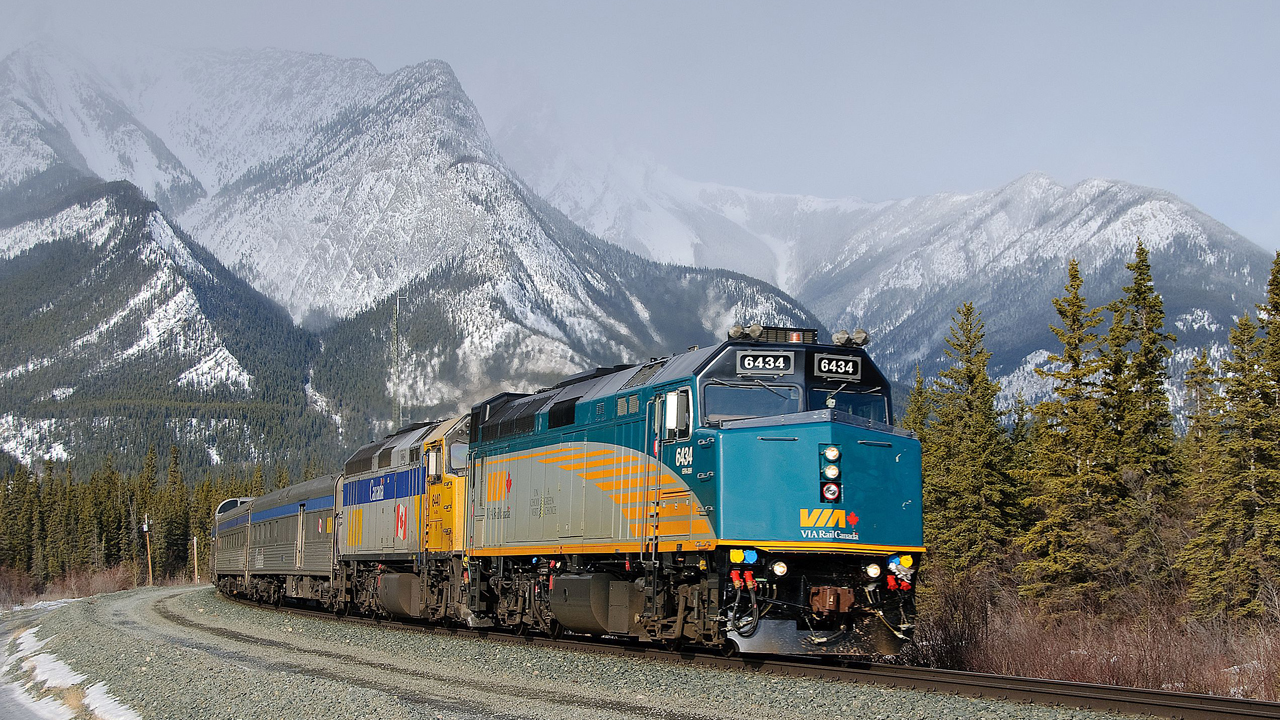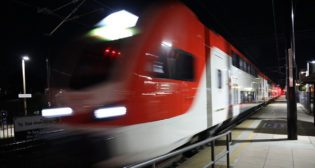
Canada to Create Separate Railway for Corridor HFR (Updated November 11)
Written by David Thomas, Canadian Contributing Editor
The Canadian at Jasper. VIA Rail photo
Transport Canada confirmed Oct. 31 that state corporation VIA Rail Canada has been shunted aside from its own project to construct and operate an electrified “High Frequency Rail” (HFR) service along the Corridor linking Quebec City, Montreal, Ottawa and Toronto—the only profitable route VIA currently covers.
A new state enterprise will be created to carry the project forward and oversee HFR operations. Technically, it will be a subsidiary of VIA Rail, but the two entities will be operated independently of each other and report directly to Transport Canada.
HFR trains will be run by a yet-to-be-chosen “Private Development Partner.” The private operator will also take over VIA Rail’s existing “local” services operating on CN and VIA Rail’s own trackage in the corridor.
The Minister also reiterated that the Government of Canada is committed to working with Indigenous Peoples to take into consideration their views as it develops options to enhance passenger rail service in Southern Ontario.
Deprived of the Corridor traffic, VIA Rail would be left only with its money-losing regional and national services, including its low-frequency and often interrupted stainless-steel streamliner The Canadian, which runs in fits and starts between Vancouver and Toronto at the operating whim of its main host railway, CN. (Unlike Amtrak, VIA Rail does not enjoy a government-mandated priority over freight operations.)
This would kill VIA Rail’s commercial viability and eventually the provision of any publicly owned passenger rail beyond the Quebec and Ontario Corridor that spans the essential electoral base of the governing Liberal Party led by Justin Trudeau (whose father, former Prime Minister Pierre Trudeau created VIA Rail in 1977).
The HFR Corridor project was first revealed by former VIA Rail CEO Yves Desjardins-Siciliao in an interview with Railway Age in January 2015. Since then, VIA Rail’s sole shareholder, Transport Canada, teased VIA Rail with a slow drip of funding for successive rounds of research and planning.
Desjardins-Siciliano cannot be entirely unhappy: He is now Canadian CEO for Siemens Mobility, which will inevitably supply the trainsets for HFR, as it does for the current renewal of VIA Rail’s existing Corridor operations. The Siemens trainsets are being built with hybrid internal combustion and pure electrical propulsion systems, easing their eventual transfer to the new HFR entity.
VIA Rail’s status as project sponsor suddenly crashed last May when then VIA Rail CEO Cynthia Garneau quit without explanation. The resignation did coincide with Transport Canada’s issuance of a “request for expressions of interest” from railway industry suppliers, without mentioning VIA Rail as a sponsor or eventual participant.
The government’s announcement that 54 companies have expressed interest in the HFR scheme included a specific declaration that VIA Rail’s existing Corridor operations will be subsumed by the new public-private HFR entity:
“Canada expects that operation of Existing VIA Services would be transitioned to the Private Partner … For clarity, Existing VIA Services refers only to the existing passenger railway services operated by VIA Rail within the Corridor.”
Thus expires public ownership of passenger rail in Canada. The eventual total demise of VIA Rail could open the way for the return of other privately operated passenger trains in Canada. The Rocky Mountaineer tourist train could conceivably extend operations eastward from Jasper and Banff to replace The Canadian. Private passenger rail companies could emerge for local services, such as one being promoted for service between Calgary Airport and Banff National Park.
On Oct. 11, Minister of Transport Omar Alghabra announced that two consulting firms “with significant expertise in the field of transportation,” CPCS Transcom Limited (CPCS), in association with WSP Canada, will act as external advisors to the federal government. CPCS and WSP, Alghabra said, “will analyze options to enhance passenger rail service in Southwestern Ontario, and submit their findings by the end of 2023. Their analysis will include examining present and future passenger rail demand, evaluating existing routes, identifying options for new alignments as needed, and providing a financial analysis.”
More than a week after this story was originally published, Transport Canada got back to me with answers to several questions. These answers don’t say a whole lot more than above. Here they are, for what they’re worth:
What is the present and future relationship between VIA and the new HFR Crown corporation?
“The new Crown corporation is being set up as a subsidiary of VIA Rail. As such, VIA Rail has been working with the federal government to establish this new office, including through incorporation, and will support the subsidiary in the development of the HFR project once it is operational. Once operational, the VIA subsidiary will lead the advancement of key HFR project activities and will work collaboratively with the eventual private partner to co-develop and optimize the HFR project during the next phase of work. Aside from supporting the VIA subsidiary in the development and implementation of this project, VIA Rail will continue to be Canada’s national passenger rail provider now and into the future.”
Will VIA and the new entity both provide Corridor services?
“The VIA Rail subsidiary is being created as a dedicated project office, with the purpose of co-developing and optimizing the HFR project in collaboration with the eventual private partner. Once the project has been fully developed and is ready for implementation, it is expected that the VIA subsidiary would enter into a contract with the private partner for the construction, maintenance and operation of HFR and VIA’s existing services in the Windsor to Quebec City Corridor. It is intended that, by transferring operations of VIA’s existing Corridor services to the private partner, it would form an integrated passenger rail system with HFR to enable seamless travel between all parts of the Corridor and improve the passenger experience. This large-scale project is being advanced in phases. Specific roles and responsibilities in the operations phase of the project, including those of VIA Rail and its subsidiary, will be subject to future Government of Canada decisions.”
What will VIA ’s mandate be after the bulk of its Corridor services have been superseded by the new HFR entity?
“VIA Rail would continue to be Canada’s national passenger rail provider. Once HFR is operational, VIA Rail is expected to continue operating its existing services outside the Corridor; as well, VIA Rail, with its subsidiary, would be responsible for managing and overseeing the contract with the private partner for the provision of intercity passenger rail services inside the Corridor. VIA Rail’s mandate would continue to be what it is now, and that is to offer safe, accessible, efficient, reliable, sustainable and environmentally friendly intercity passenger rail services that meet the needs of Canadians.”
Why Transport Canada decide VIA Rail was not the right entity to pursue this project to completion?
“HFR is a large, complex project. That is why the VIA Rail subsidiary is being set up—to act as a dedicated project office—whose main purpose will be to co-develop and optimize the HFR project in collaboration with the private partner. It will have the flexibility, independence, and corporate agility to advance the project. Ultimately, this dedicated project office allows VIA Rail to continue focusing on the delivery of national passenger rail services more broadly, while supporting the subsidiary in the HFR project’s advancement. Having the VIA subsidiary working collaboratively with the private partner is considered the best approach to promoting innovation, designing better service for travellers, improving risk management, and ultimately delivering a high-quality HFR system for Canadians.”

David Thomas is a reporter who has covered government and society since graduating from Ottawa’s Carleton University with degrees in political science and journalism. He has written for National Geographic, Maclean’s, The Globe and Mail, The Gazette, and The Canadian Press news agency from postings in Ottawa, Montreal, Quebec City, Toronto, and London, England. “Railroading has been a personal fascination since a childhood timed fortunately enough to witness the golden years of steam on the late-to-dieselize Canadian National and Canadian Pacific,” he says. The opinions expressed here are his own.



